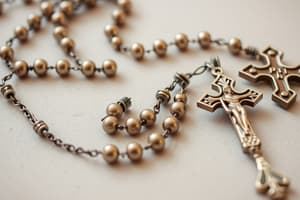Podcast
Questions and Answers
What does the term 'rosary' mean in Latin?
What does the term 'rosary' mean in Latin?
- Rose garden (correct)
- Spiritual connection
- Count of prayers
- Prayer beads
In which century did the use of beads for prayer gain popularity among monastics?
In which century did the use of beads for prayer gain popularity among monastics?
- 9th century
- Middle Ages (correct)
- 11th century
- 18th century
How many beads were commonly used in the 12th century to correspond with the Psalms?
How many beads were commonly used in the 12th century to correspond with the Psalms?
- 50 beads
- 100 beads
- 150 beads (correct)
- 200 beads
Who popularized the rosary in the 13th century?
Who popularized the rosary in the 13th century?
What did Pope Pius V establish in the 16th century regarding the rosary?
What did Pope Pius V establish in the 16th century regarding the rosary?
What are the traditional prayers included in the rosary?
What are the traditional prayers included in the rosary?
Initially, how many mysteries were included in the rosary?
Initially, how many mysteries were included in the rosary?
Which pope added the Luminous Mysteries to the rosary?
Which pope added the Luminous Mysteries to the rosary?
What is one unique variation of the rosary mentioned?
What is one unique variation of the rosary mentioned?
What role does the rosary play in modern spirituality?
What role does the rosary play in modern spirituality?
Flashcards are hidden until you start studying
Study Notes
History of Rosaries
-
Origins:
- The term "rosary" comes from the Latin word "rosarium," meaning "rose garden."
- Early Christian prayer beads can be traced back to the 3rd century for counting prayers.
-
Medieval Development:
- The use of beads for prayer became popular in the Middle Ages, particularly among monastics.
- In the 12th century, it was common to use 150 beads to correspond with the 150 Psalms.
-
Dominican Influence:
- The rosary was popularized in the 13th century by St. Dominic, who founded the Order of the Dominicans.
- According to tradition, Mary appeared to St. Dominic and instructed him to promote the rosary.
-
Formalization:
- In the 16th century, Pope Pius V established the "Rosary of the Blessed Virgin Mary," standardizing the structure of the rosary.
- The traditional form consists of 53 Hail Marys, 6 Our Fathers, and varies in configuration.
-
15 Mysteries:
- Over time, groups of prayers called "mysteries" were introduced, reflecting on events in the lives of Jesus and Mary.
- Initially, there were 15 mysteries (Joyful, Sorrowful, and Glorious); the Luminous Mysteries were added by Pope John Paul II in 2002.
-
Cultural Variations:
- Different cultures have developed unique styles and uses for the rosary.
- Some variations include the "Wrist Rosary" and "Chaplet," which have fewer beads and focus on specific prayers or intentions.
-
Modern Day:
- The rosary remains a popular form of prayer among Catholics.
- It serves both as a tool for meditation and a means of spiritual connection.
-
Papal Endorsement:
- Numerous popes have endorsed the rosary as an important spiritual practice, emphasizing its role in personal devotion and community prayer.
Origins
- "Rosary" comes from the Latin word "rosarium" meaning "rose garden".
- Christian prayer beads have been used since the 3rd century.
- Beads were used originally to count prayers.
Medieval Development
- Bead prayer became popular in the Middle Ages, especially among monastics.
- 150 beads were used to correspond with the 150 Psalms.
Dominican Influence
- The rosary was popularized in the 13th century by St. Dominic, founder of the Order of the Dominicans.
- Tradition holds that Mary instructed St.Dominic to promote the rosary.
Formalization
- Pope Pius V established the "Rosary of the Blessed Virgin Mary" in the 16th century.
- The standard form is 53 Hail Marys, 6 Our Fathers.
- Configurations of the rosary can vary.
15 Mysteries
- "Mysteries" were introduced as groups of prayers reflecting on events in the lives of Jesus and Mary.
- There were originally 15 mysteries (Joyful, Sorrowful, and Glorious).
- Pope John Paul II added the Luminous Mysteries in 2002.
Cultural Variations
- Cultures have developed unique rosary styles and uses.
- Variations include the "Wrist Rosary" and "Chaplet" with fewer beads for specific prayers or intentions.
Modern Day
- The rosary remains popular among Catholics.
- It is used for meditation and spiritual connection.
Papal Endorsement
- Numerous popes have endorsed the rosary as a spiritual practice.
- It is promoted for personal devotion, and community prayer.
Studying That Suits You
Use AI to generate personalized quizzes and flashcards to suit your learning preferences.




